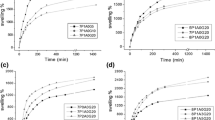Abstract
Rheological and swelling properties of hydrogels based on pullulan crosslinked with sodium trimetaphosphate (STMP) are explained according to various polymer and crosslinking agent concentrations using 31P-nuclear magnetic resonance study. This method has allowed determining the amount of all the species present in the medium when varying both pullulan and STMP concentrations. We have clearly demonstrated with a good agreement by both 31P-NMR and rheology that a critical STMP concentration occurs which is function of pullulan concentration. This typical crosslinking agent concentration delimitates the maximum of gel structure together with the minimum of swelling.








Similar content being viewed by others
References
Peppas NA, Bures P, Leobandung W, Ichikawa H (2000) Hydrogels in pharmaceutical formulations. Eur J Pharm Biopharm 50:27–46
David L, Dulong V, Le Cerf D, Chauzy C, Norris V, Delpech B, Lamacz M, Vannier JP (2004) Reticulated hyaluronan hydrogels: a model for examining cancer cell invasion in 3D. Matrix Biol 23:183–193
Coviello T, Matricardi P, Marianecci C, Alhaique F (2007) Polysaccharide hydrogels for modified release formulations. J Control Release 119:5–24
Code of Federal Regulations (1995) Food additives permitted in food for human consumption, Chap 1. Part 172, Section 892. US Government Printing Office, Washington
Khondkar D, Tester RF, Karkalas J (2009) Effect of cross-linking on the resistance to enzymatic hydrolysis of waxy maize starch and low-methoxy pectin. Food Hydrocolloid 23:387–393
Kerr RW, Cleveland FC (1957) Process for the preparation of distarch phosphate and the resulting product. US Patent. No. 2,801,242
Lim S, Seib PA (1993) Preparation and pasting properties of wheat and corn starch. Cereal Chem 70:137–144
Lim S, Seib PA (1993) Location of phosphate-esters in a wheat-starch phosphate by 31P NMR spectroscopy. Cereal Chem 70:145–152
Woo K, Seib PA (1997) Cross-linking of wheat starch and hydroxypropylated wheat starch in alkaline slurry with sodium trimetaphosphate. Carbohydr Polym 33:263–271
Woo K, Seib PA (2002) Cross-linked resistant starch: preparation and properties. Cereal Chem 79:819–825
Sang Y, Prakash O, Seib PA (2007) Characterization of phosphorylated cross-linked resistant starch by 31P nuclear magnetic resonance spectroscopy. Carbohydr Polym 67:201–212
Carmona-Garcia R, Sanchez-Rivera MM, Méndez-Montealvo G, Garza-Montoya B, Bello-Pérez LA (2009) Effect of the cross-linked reagent type on some morphological, physicochemical and functional characteristics of banana starch (Musa paradisiaca). Carbohydr Polym 76:117–122
Sang Y, Seib PA, Herrera AI, Prakash O, Shi YC (2010) Effects of alkaline treatment on the structure of phosphorylated wheat starch and its digestibility. Food Chem 118:323–327
Gliko-Kabir I, Yagen B, Penhasi A, Rubinstein A (2000) Phosphated crosslinked guar for colon-specific drug delivery I. Preparation and physicochemical characterization. J Control Release 63:121–127
Leone G, Torricelli P, Giardino R, Barbucci R (2008) New phosphorylated derivatives of carboxymethylcellulose with osteogenic activity. Polym Adv Technol 19:824–830
Liu M, Fan J, Wang K, He Z (2007) Synthesis, characterization, and evaluation of phosphated cross-linked konjac glucomannan hydrogels for colon-targeted drug delivery. Drug Deliv 14:397–402
Dulong V, Lack S, Le Cerf D, Picton L, Vannier JP, Muller G (2004) Hyaluronan-based hydrogels particles prepared by crosslinking with trisodium trimetaphosphate. Synthesis and characterization. Carbohydr Polym 57:1–6
Bejenariu A, Popa M, Dulong V, Picton L, Le Cerf D (2009) Trisodium trimetaphosphate crosslinked xanthan networks: synthesis, swelling, loading and releasing behaviour. Polym Bull 62:525–538
Lack S, Dulong V, Le Cerf D, Picton L, Argillier JF, Muller G (2004) Hydrogels based on pullulan crosslinked with sodium trimetaphosphate (STMP): rheological study. Polym Bull 52:429–436
Lack S, Dulong V, Picton L, Le Cerf D, Condamine E (2007) High-resolution nuclear magnetic resonance spectroscopy studies of polysaccharides crosslinked by sodium trimetaphosphate: a proposal for the reaction mechanism. Carbohydr Res 342:943–953
Mocanu G, Mihaï D, Le Cerf D, Picton L, Muller G (2004) Synthesis of new associative gel microsphere from carboxymethyl pullulan and their interactions with lysozyme. Eur Polym J 40:283–289
Dulong V, Le Cerf D, Picton L, Muller G (2006) Carboxymethylpullulan hydrogels with a ionic and/or amphiphilic behavior: swelling properties and entrapment of cationic and/or hydrophobic molecules. Colloid Surf A 274:163–169
Li Y, de Vries R, Slaghek T, Timmermans J, Stuart MAC, Norde W (2009) Preparation and characterization of oxidized starch polymer microgels for encapsulation and controlled release of functional ingredients. Biomacromolecules 10:1931–1938
Acknowledgments
This research is supported by the Réseau Matériaux Polymères Plasturgie (RMPP) and the Région Haute-Normandie.
Author information
Authors and Affiliations
Corresponding author
Rights and permissions
About this article
Cite this article
Dulong, V., Forbice, R., Condamine, E. et al. Pullulan–STMP hydrogels: a way to correlate crosslinking mechanism, structure and physicochemical properties. Polym. Bull. 67, 455–466 (2011). https://doi.org/10.1007/s00289-010-0435-2
Received:
Revised:
Accepted:
Published:
Issue Date:
DOI: https://doi.org/10.1007/s00289-010-0435-2




